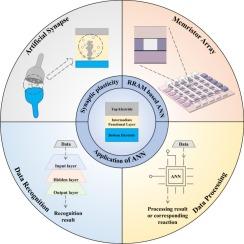Resistive random access memory based artificial neural network for brain-inspired neuromorphic computing
IF 22
1区 材料科学
Q1 MATERIALS SCIENCE, MULTIDISCIPLINARY
引用次数: 0
Abstract
Due to the limitations of size reduction in traditional memory and the von Neumann bottleneck of traditional computing systems, neuromorphic computing based on resistive random access memory (RRAM) has become a promising candidate in artificial intelligence algorithms. RRAM consists of metal two electrode layers sandwiching an intermediate functional layer, the functional layer of RRAM offers exceptional versatility in material selection, which allows RRAM devices to exhibit distinct performance characteristics. The principle of RRAM relies on modulating resistance through controlled formation and rupture of conductive filaments in the functional layer via electrical or other stimuli, which enables both resistive switching and multilevel cell (MLC) storage characteristics. These characteristics enable synaptic plasticity-mimicking biological synapses that update their weights through action potential (AP) transmission. This intrinsic similarity makes RRAM particularly suitable for emulating synaptic functions in neuromorphic systems. Inspired by the brain’s architecture, researchers have engineered memristor arrays using RRAM devices to emulate densely interconnected biological synapses. Advanced implementations include three-dimensional (3D) memristors with multi-layer structures and hybrid systems integrating RRAM with complementary hardware/software platforms. These innovations have facilitated the development of artificial neural networks (ANNs) based on RRAM technology, which are now being deployed for high-efficiency data processing and recognition tasks. This paper begins with RRAM materials, providing a detailed analysis of RRAM’s Resistive switching, ultra-low power consumption, reliability, and MLC storage characteristics. It comprehensively summarizes the synaptic plasticity of RRAM based artificial synapses, including short-term plasticity (STP) and long-term plasticity (LTP), classical Pavlov’s dog experiments, and spike-timing-dependent plasticity (STDP) and spike-rate-dependent plasticity (SRDP). Building on this foundation, this paper introduces RRAM based ANNs and divides them into four different types according to its components and spatial structure, and then deeply discusses the application of artificial neural network (ANN) in data processing and recognition. Finally, challenges and outlooks of RRAM for neuromorphic computing are also deeply discussed.

基于电阻随机存取存储器的人工神经网络在脑启发神经形态计算中的应用
由于传统存储器尺寸减小的限制和传统计算系统的von Neumann瓶颈,基于电阻随机存取存储器(RRAM)的神经形态计算已成为人工智能算法中一个很有前途的候选算法。RRAM由金属两个电极层夹在中间功能层组成,RRAM的功能层在材料选择上提供了卓越的多功能性,这使得RRAM器件具有独特的性能特征。RRAM的原理依赖于通过电或其他刺激控制功能层导电丝的形成和破裂来调制电阻,从而实现电阻开关和多电平单元(MLC)存储特性。这些特性使得模仿突触可塑性的生物突触能够通过动作电位(AP)传递更新它们的重量。这种内在的相似性使得RRAM特别适合模拟神经形态系统中的突触功能。受大脑结构的启发,研究人员设计了使用RRAM设备的忆阻器阵列来模拟紧密相连的生物突触。先进的实现包括多层结构的三维(3D)忆阻器和将RRAM与互补的硬件/软件平台集成在一起的混合系统。这些创新促进了基于RRAM技术的人工神经网络(ann)的发展,目前正用于高效的数据处理和识别任务。本文从RRAM材料开始,详细分析了RRAM的电阻开关、超低功耗、可靠性和MLC存储特性。全面总结了基于RRAM的人工突触的突触可塑性,包括短期可塑性(STP)和长期可塑性(LTP),经典巴甫洛夫狗实验,以及spike- time -dependent plasticity (STDP)和spike-rate-dependent plasticity (SRDP)。在此基础上,介绍了基于RRAM的人工神经网络,并根据其组成和空间结构将其分为四种不同的类型,深入探讨了人工神经网络在数据处理和识别中的应用。最后,对RRAM在神经形态计算领域面临的挑战和前景进行了深入讨论。
本文章由计算机程序翻译,如有差异,请以英文原文为准。
求助全文
约1分钟内获得全文
求助全文
来源期刊

Materials Today
工程技术-材料科学:综合
CiteScore
36.30
自引率
1.20%
发文量
237
审稿时长
23 days
期刊介绍:
Materials Today is the leading journal in the Materials Today family, focusing on the latest and most impactful work in the materials science community. With a reputation for excellence in news and reviews, the journal has now expanded its coverage to include original research and aims to be at the forefront of the field.
We welcome comprehensive articles, short communications, and review articles from established leaders in the rapidly evolving fields of materials science and related disciplines. We strive to provide authors with rigorous peer review, fast publication, and maximum exposure for their work. While we only accept the most significant manuscripts, our speedy evaluation process ensures that there are no unnecessary publication delays.
 求助内容:
求助内容: 应助结果提醒方式:
应助结果提醒方式:


